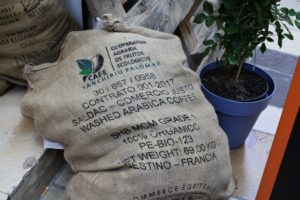
Tag: Provence
Provence…Here We Come Again
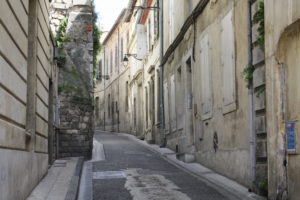
Have You Been to a Parfumerie?
The appeal of perfume is that it is at once ephemeral and empowering…~ Mary Gaitskill
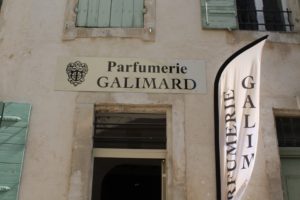
Traveling is experiencing. At least, it is for me.
So, when in Saint Remy de Provence I decided to make an appointment at a parfumerie. A new experience for me.
I thought maybe I would get an understanding of the process by watching a professional make perfume. But, it was much more than just sitting down while someone mixed up different scents. This was going to be a hands-on, nose-involved, one-on-one lesson in making my own perfume.
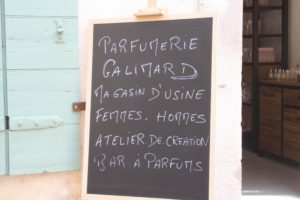
Jars, bottles, photos, coffee beans, and assorted mixing sticks were arranged on the bar in front of me. My own personal mini-lab.
Catherine, at Parfumerie Galimard, is schooled in the science of perfumery and has her credentials. She was my teacher for the afternoon.
Before we started, she explained what a base note is and how it differs from a heart note and from a head or top note. I also learned there’s a fragrant farm just 4 km from Grasse, in the south of France. Yes, a fragrant farm. For five consecutive generations one family has grown the May rose exclusively for the Channel No 5 scent. Yep. All 35 to 40 tons of May rose petals are processed for Channel.
Did you know that four tons of roses equals about 1,600,000 rose blossoms? And, that equals one kg of rose oil? No wonder some perfumes are expensive.
And, the town of Grasse. Jean de Galimard lived in Grasse in 1747, where he created Parfumerie Galimard. During this time, he supplied the court of Louis, King of France, with olive oil, and pomades and perfumes developed from his own formulas. These scents were used to enhance gloves of the fashionable crowd.
Today, those same processes and the natural resources of Grasse are still being used. Jasmine, rose, lavender, orange flower, and tuberose are some of the most widely used to obtain the rich scents necessary for quality perfumes.
“Okay, enough history.” Catherine told me. “You’re going to make your own scent. It will be based on your preferences. Are you ready to work?”
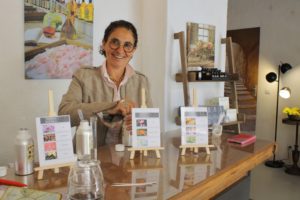
Are you kidding? Of course.
So, where did we start? Catherine told me to make a fine perfume, you need to start with the best raw materials. Just like they did in King Louis’ time. “You must know where these materials came from and how they are grown.”
Then, she said they need to be mixed correctly to achieve the scent you’re looking for.
To do this, parfumeurs use the olfactory pyramid. Ingredients in any perfume are organized on three levels, based on their evaporation rates.
First, are the top or head notes. These are light, fresh, and very volatile scents. They are the ones you first smell. But, they’re also the ones to evaporate first. They can be energetic and exciting, catching your attention and involving your senses. According to Catherine, you might even think this is the essences of this perfume. You probably get smells of lemon, orange, tangerine, bergamot. Others like ginger, eucalyptus, lavender, thyme, sage and rosemary come through as well.
The next level is the middle or heart notes. These should be perceived immediately right after the head notes. They’re stronger and more sensual, awakening deep sensations. At times, they can even mask strong base notes. Smells like peach, rose, thrush, freesia, tuberose, chamomile, jasmine, green land, or oceans come through.
Last are the base notes. They’re the last ones to be perceived. They appear slower but evaporate gradually, lasting longer. These are the ones which give your perfume its personality. You might find scents like incense, patchouli, cedarwood, sandalwood, iris, heliotrope, vanilla, caramel, cocoa, coffee, mush, leather, and birch. They stabilize other scents and are often used for the relaxing and calming effect.
“Getting the right mix of top, heart, and base notes is what makes a great parfume. Each person smells those notes differently. Getting it the way you like makes your great parfume.
“When we’re finished, I will show you how to wear your new scent.” And, she did.
Now, time to start. Catherine took me through the process of smelling and mixing. She handed me the jar of coffee beans. “Smelling coffee beans in between scents cleanses those scents from your nose. Much like the process when you sniff different wines.” More smelling and mixing followed. It was a fun-filled, educational hour and a half.
I lost track of the number of combinations of top, heart, and base notes I smelled. She took me through a series of scents, telling me not to comment whether I liked it or not. More coffee beans to sniff. Then, I went back and smelled them again. By then, I did have preferences.
When we were finished, I had my own unique formula. My recipe. I walked away with my own bottle and an appreciation of what goes into making perfume. It’s a lot more complicated than I imagined.
By the way, they keep that formula on hand in case I want to re-order. Smart.
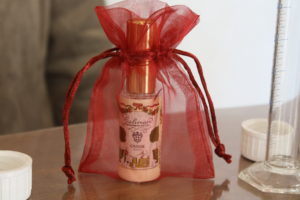
If You Go:
http://www.galimard.com/index.php/en/la-source-parfumee.html
Eat Your Way Through the Markets in Provence
You could literally go to some type of street market every day in Provence. Really.
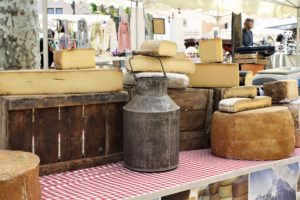
Whether you’re looking specifically for antiques, linens, clothes, soaps, collectibles, knives, cough drops made with balsamic, flowers, fabrics, shoes, spoons and spatulas made from olive wood, lavender everything…the list goes on and on.
Antiques had their own places at most markets. Door knobs, boules, picture frames, wooden boxes, iron toys, tools, rusted, faded signs, and more.
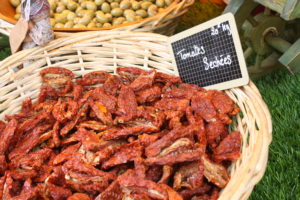
Then, there’s food. Olives of every color and size, fresh-baked breads, local meats, cured hard and soft salamis, chocolate and nougat candies, countless creamy and pungent cheeses, frozen and fresh fish, seasonal fruits, spices from all corners of the globe, red, black, white, and green poivre, jars of duck fat, local specialty cookies from that region, bunches of herbs, garlic bigger than my hand, colorful vegetables…this list is even larger.
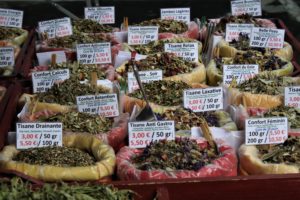
You could spend all day.
So…we went. To several.
We opted for a morning here and there. Which means we spent several different times at different markets in different towns and villages. Streets lined with vendors, side streets filled with flowers, and people everywhere.
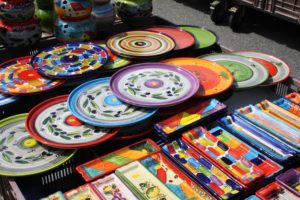
We saw some of the same vendors at multiple places. And, we discovered new ones. We now have favorites.
This is what we discovered…
Everyone was polite. No one pushed to get in line before anyone else. Everybody said ‘Bonjour’, ‘Merci’, and ‘Au Revoir.’
Locals shop for food and whatever else they need. Chefs shop for whatever is in season. You’ll find whatever they buy on the menu today. Could be ripe, mouth-dripping strawberries, which were in season in May. Maybe those would end up in desserts. Could be fat, creamy-white asparagus, also in season in May. Soup made from them looks like cream and tastes like silk with a hint of white pepper. Maybe you’ll find quail eggs, the latest flavor of sausage, or pureed beet root.
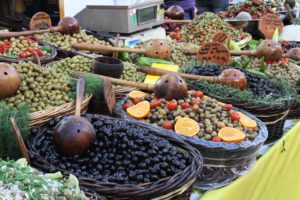
Nougat made an appearance at every market as well. Flavored with anything from pistachios to apricots to dried fruits. Sweet treat.
There are always plenty of cheeses to pick from. How about an aged Comte? Sharp, pungent, and an absolute favorite. Or, the just-made goat cheese…this came as a dessert with an apricot puree. To die for. I didn’t think it was appropriate to lick the plate when I was finished. I wanted to.
Bread vendors sell out early. Get your baguette first thing if you want one. Everybody else does. That way you can carry it like the French do. Wrapped in plain paper, under your arm or in your market bag.
We saw the same organ grinder at two different markets. No monkey. The organ grinder at a third market had a large cat with him. He was on a leash and accepted treats. Go figure.
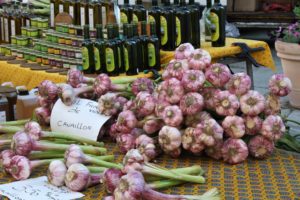
Wine vendors give out samples. Of course, every vendor gives out samples. What better way to try before you buy?
Another favorite were the spoons, spatulas, and serving platters made from olive wood. Beautiful doesn’t begin to describe them. Use them and they will quickly become your favorite.
Colorful linens for tables, dishcloths, napkins, and hand towels lit up the aisles. Brilliant blues, bright yellows, deep reds, and blinding whites… What color do you want?
Scarves and cashmere pashminas in more shades of blue than I’ve ever seen. Was the scarf guy telling me the truth when he said that color was made for me?
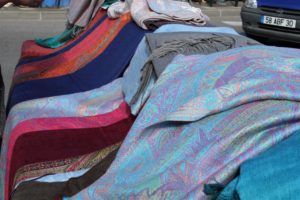
Baskets vied with their own colors, shapes, and sizes for attention. I could just see my cat adopting one of them. But, I’d have to get it on the plane and it wouldn’t fit in my carry-on.
Assume there is one vendor for each type of food or item…and you would be wrong. This is another thing which amazed us. The number of vendors selling the same or similar items was amazing. Each had their own twist, specialty, or way of selling.
At one market, we saw at least four olive vendors and five sausage makers. Another time, there were over seven vendors with table linens. Everybody seemed to be doing a brisk business. I guess if you weren’t…you probably didn’t return.
Did I mention the duck fat? Small jars, large jars, duck fat and beans, foie gras, foie gras with duck fat…there was definitely a love affair with duck fat. AKA…graisse de canard.
Paella cooked in yard-wide pans looked and smelled like saffron coated fish. Yum. Croissants so flaky we wore the crumbs all day. Of course, our espressos were the perfect accompaniment. Whatever you’re hungry for, breakfast, lunch, or café au lait, find your favorite food. It’s probably at the street market.
At the end of the morning, we left with provisions for that night’s dinner, snacks to eat throughout the day, linens to bring home, and memories of what we tasted and saw. Those croissant crumbs? They stayed with us.
We’re already making plans to go back. Provence and street markets…a match made for us.
Eat and Drink Through Avignon
Stay tuned for my story of eating and drinking our way around Avignon.
